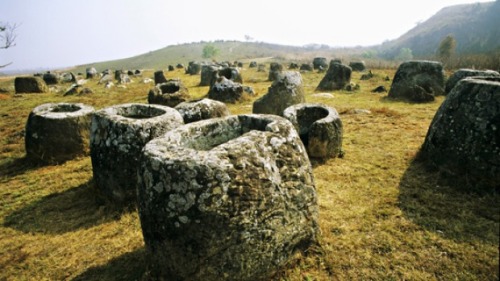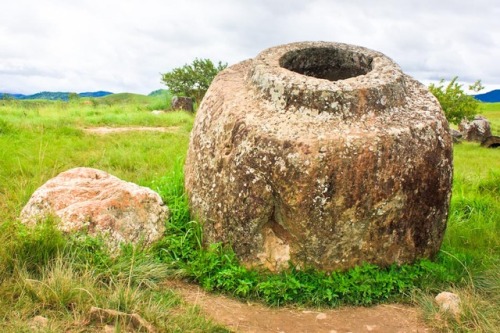starling-song: theoldstone: The Plain of Jars is an ancient megalithic archaeological site in Laos c
starling-song: theoldstone: The Plain of Jars is an ancient megalithic archaeological site in Laos consisting of thousands of stone jars scattered through the valleys and foothills of the Xiankhoang Plateau. The Plain of Jars has been dated to the Iron Age, sometime between 500 BC and AD 500 and is considered to be one of the most important prehistoric sites in Southeast Asia.Over 90 ‘jar sites’ have been discovered; each home to somewhere between 1 to 400 jars. Each of the jars vary in height and size, and are anywhere from 1 meter to 3 meters tall. They are hewn directly from rock, mostly sandstone, and are undecorated. While most of the jars have lipped rims, very few lids have ever been discovered.The purpose of the jars can, of course, really only be theorized. Lao legends describe a race of giants who, after winning a great battle, brewed huge amounts of rice wine to celebrate their victory, and built the jars to store it all. Another tells that the jars were simply molded from a mixture of clay, sand, and sugar to function as kilns for pottery. But perhaps the most practical of these explanations is that the jars were used to collect monsoon rainwater for caravan travellers. Even stagnant, the rain water in the jars could be boiled until potable, and archaeologists have observed this practice in many Eastern Eurasian countries already. Beads found inside the jars could have been a travellers offering, accompanied by a prayer for more rain.More scientific study of the jars offers different insights. The initial study of the jars, conducted by Madeleine Colani in 1935, suggests that they were personal crematoriums. Inside many of the jars she studied, Colani found black organic soil, glass beads, and burnt teeth and bones. This conclusion was widely accepted namely because there wasn’t any further study of the site until 1994—almost 60 years later. While the 1994 study would ultimately corroborate Colani’s findings, it’s worth mentioning the nature of the delay: Laos has the unfortunate distinction of being the world’s most bombed country, and of the hundreds of thousands of bombs dropped and planted during the Vietnam War and the Laotian Civil War, 30% did not detonate, leaving 10 of the 18 provinces in Laos “severely contaminated” by both bomb-related refuse and debris, and unexploded ordinance. Of the 90 jar sites, only 7 are open to the public as a result, and further research into the stones still proves incredibly difficult to this day. These are super cool!! And it really freaking sucks that people are still dying in Laos because America dropped bombs on them over forty years ago!! No one in America knows where Laos is but if I tell them that the United States turned it into the most bombed country in the history of the world, then they’re even more confused and occasionally accuse me of lying about why my mother and her family left their home in the dead of night and lived in a refugee camp for much of her elementary-school-age years. Fun!! I love our education system!! -- source link
Tumblr Blog : theoldstone.tumblr.com





